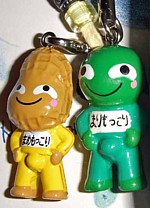
Bad news for rice in Japan -- the recent tainted rice scandal has dulled the public's appetite for the staple, and kids these days are consuming less than ever. In an attempt to revive interest in the grain, agricultural cooperative JA Ugo (based in Ugo, Akita prefecture) is enlisting the help of a sweet, doe-eyed anime rice farmer girl.
Designed by eroge illustrator Aoi Nishimata, the original moe character will appear on 10,000 bags of locally grown "Akitakomachi" rice, which will go on sale September 22. Some Tokyo department stores have reportedly said the bags seem out of place on their shelves, but JA Ugo believes young people will embrace the design. The moe rice will undoubtedly sell well, provided it's free from mold and pesticide.
In recent weeks, consumers have been shocked to learn that moldy rice tainted with the pesticide methamidophos was served to thousands of people at schools, day-care centers and nursing homes and included in a variety of commercial food products. The tainted rice was originally imported from China for use as a raw material in industrial products such as glue, but was instead distributed as food. There have been no reports of people getting sick from the tainted rice.
[Source: Asahi // Image: Aoi Nishimata]



 The company came up with the idea for Kirichimpo last year after witnessing the far-reaching success of Marimokkori, a happy, well-endowed green monster mascot from Hokkaido, whose name is a play on the words marimo (a type of giant algae ball found in Lake Akan) and mokkori ("erection"). Marimokkori's popularity extends far beyond Hokkaido's shores, to as far away as Chiba, the home of his younger peanut-headed cousin named Mamemokkori (mame means "bean"), and Tokyo, where mounds of the popular Marimokkori can be found inside UFO Catcher claw vending machines at game centers.
The company came up with the idea for Kirichimpo last year after witnessing the far-reaching success of Marimokkori, a happy, well-endowed green monster mascot from Hokkaido, whose name is a play on the words marimo (a type of giant algae ball found in Lake Akan) and mokkori ("erection"). Marimokkori's popularity extends far beyond Hokkaido's shores, to as far away as Chiba, the home of his younger peanut-headed cousin named Mamemokkori (mame means "bean"), and Tokyo, where mounds of the popular Marimokkori can be found inside UFO Catcher claw vending machines at game centers.